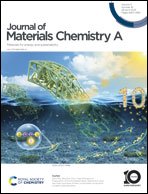Molecular structure – intrinsic photostability relationships for diketopyrrolopyrrole-based conjugated polymers†
Abstract
Widespread practical application of organic solar cells requires their long-term operational stability, a prerequisite which has not yet been achieved. Achieving long device lifetimes depends on the availability of intrinsically stable absorber materials and a thorough understanding of their degradation pathways; both of these aspects are still insufficiently explored. In this work, we present a systematic study of a series of 18 conjugated polymers composed of diketopyrrolopyrrole (DPP) subunits combined with various kinds of other building blocks. It has been shown that the DPP unit itself substantially accelerates the degradation of conjugated polymers due to its favorable photochemical transformation into, as we experimentally and theoretically demonstrate, 1,4-di(thiophen-2-yl)but-2-yne-1,4-diamine (major product) and 1,4-di(thiophen-2-yl)benzene (minor product). Using a set of complementary analytical techniques, we compared the degradation rates of various polymers and established some important correlations between the molecular structures of the materials and their intrinsic photostability. The revealed relationships provide valuable new guidelines for furthering the rational design of new organic absorber materials with largely enhanced photochemical stability.



 Please wait while we load your content...
Please wait while we load your content...